 Bundesmarine, Type 122. Built 1979-90, in service until 2020.
Bundesmarine, Type 122. Built 1979-90, in service until 2020.F207-214 Bremen, Niedersachsen, Rheinland-Pfalz, Emden, Köln, Karlsruhe, Augsburg, Lübeck
The eight F122 Bremen-class frigates commissioned between 1982 and 1990 constituted the modern backbone of the Bundesmarine in the late cold war, and up recently. Their design was a complete U-turn compared to the previous 1961 Köln, criticized as being top-heavy, unstable and crowded. Instead, the BDR choosed the proven and robust Dutch Kortenaer class (a true Euro best seller) and change the propulsion system and hangar layout to be primary anti-submarine warfare platforms alhtough lacking a VTS, and having AA point-defence. They were also the last German ship under post-war displacement imposed limitations and proved easy to modernize. They were replaced recently by the new F125 (Baden-Württemberg) frigates.
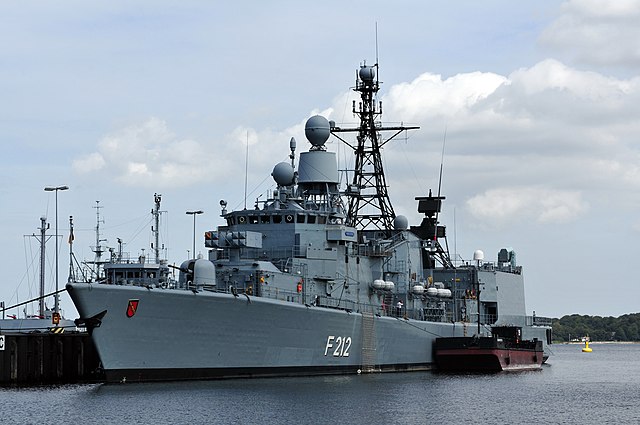
Karlsrhüe in Kiel
They served actively in the late cold war and 1990s conflicts, aside multinational Atlantic and Mediterranean NATO stands and exercises, they took part in the Gulf war, Ex-Yugoslavian war, and many operations between the middle east and red sea, as well as high profile deployments in anti-miracy missions on the horn of Africa. They had been retired and replaced recently by the new F125 (Baden-Württemberg) frigates. #bundesmarine #germannavy #frigates #coldwar #bremen #emden #karlsruhe #augsburg #luebeck #niedersachsen
Development
Preparatory works for these ships went back in the mid-1960s when all designs for the Bundeswehr built on experience of wartime officers and civil servants which served in the Kriegsmarine but which re-enlisted. The German shipbuilding industry had a ten-year gap in design experience to catch up, leading to ships that were commendable such as the Hamburg and Köln classes but they suffered from the WEU’s displacement limit, and were frequently overweight and with a poor seaworthiness. Once all limits were lifted, more balanced designed could be envisioned. The Types 101 and 120 already were tasked to escort convoys against submarines and aircraft and jeep a minelaying ability. For these, these early types had early warning radars and competent gun-directors for quick reaction, 100mm turrets and 40mm guns plus torpedo tubes, and a steam turbines or diesels and gas turbines but they became quickly obsolete due to a variety of factords, notably the advaent of better missiles and better Soviet nuclear attack submarines. The November and its follow-up armed with missiles were capable of 30 knots underwater.
This there were preliminary studies for a follow-up to the Köln class in the 1965, called at first an “AA corvette” of 1200t displacement, ten to be built. But it was clear that for a better ASW set, the displacement had to rise to 2500t. The restricted defence budget had this project cancelled. Instead the Lütjens class destroyers were acquired as well as the ten Zobel class FACs modernized. In 1968 the programme ‘Frigate 70’ was however relaunched, and several designed were proposed, until the budgetary board accepted the programme on 23 January 1969 and later the defence board of the Bundestag, on 8 February 1969. However at that stage the design proposed was not completed and cancelled for this year. Based on a new 3,600t hull, costs also ballooned.
Design studies restarted from scratch in 1970, this time looking and comparing foreign frigate designs. This was a long process, from 1971 to 1974. In the end, the Netherlands Standard frigate (Kortenaer) received all suffrages. On 17 July 1975, a Memorandum of Understanding with the Netherlands was signed signed by the German Defence Board on 28 January 1976.
On 26 November 1977, six derivative (saving design time) were ordered as Type 122, then two more on 6 December 1985. The NATO Sea Sparrow was adopted as well as two Mk 88 Lynx with their DAQS-13D dipping sonar for ASW patrols as well as the Canadian “Bear Trap” system for them to land in any weather.
Design of the class
Hull and general design
The F122 Frigates were rated as 3,680 tonnes (3,620 long tons) ships, for an overall length of 130.50 m (428 ft 2 in), a beam of 14.60 m (47 ft 11 in) and draft of 6.30 m (20 ft 8 in). Complement was 202 crew plus 20 aviation crew. Design, wise, they owned a lot of cross-influences with the Dutch Kortenaer class “standard” frigates. The Dutch design was selected indeed for Germany, but with many modifications. They ended with the same general design, with three islands, a taller bridge, amidship blocky funnel, aft structure cut aft by the massive hangar. They were more seaworthy with a taller fush deck hull, while the forward island’s bridge was four evel high over the prow instead of two levels. It supported the primary radar FCS and a small derrick mast and main 3D radar.
This forward bridge was three-tiered, with the Sea Sparrow (replacing the obsolete Tartar) superfiring over the single main gun, of larger caliber. Two smaller 20 mm guns were installed aft of the bridge block. Behind it on deck were located two sets of four Harpoon SSM, angled up and facing starboard and port. Behind it was located the admiship island, low, supporting the main blocky funnel fitted with therma reduction systems. Just forward of it was located the blocky support for the derrick main mast supporting other aerials.
There was a single service whaler located under davits on the port side. The crew in emergency was supposed to use the dozens of standard NATO capsuled inflatable rafts. Once the capsule was thrown at sea, a detector opened immediately it and inflated rapidly the raft.
Aft, there was the blocky hangar, tall enough to accomodate two helicopters side by side and all the necessary parts for maintenance and repair, including some suspended under the roof. There was also a small bridge to monitor air operations with a radio operator.
The aft section was double: A lower aft poop deck with all the necessary equipment for harbour service, and VDS, and above the helideck, creating a gallery. The latter was too small however to allow operating two helicopters at once, just one taking off or landing. It was reinforced in order to operate averything between the Westland Lynx and Sea King. Indeed 22 Sea King Mk.41s were acquired by the Bundesmarine on 20 June 1969 as a replacement for the Grumman Albatross. Albeit based on shore, they could perform long haul missiles and SAR if needed landing and taking off from the Frigates.
The Class 122 frigates had an onboard organization in main sections:
HA 100: Navigation: All controls of the ship, including deck service
HA 200: Energy department, divided into propulsion, electrical engineering and ship operation, maintenance in propulsion, electricity, water, heat, cold supply, waste water treatment and safety departments.
HA 300: Command and weaponry section, combat readiness of all armament and electronic systems.
HA 400: Central services, administration (salary, human resources) supplies, food and medical care
HA 500: Helicopter section with the pilots, staff, maintenance crew and parts management.
HA 600: combat section, communication, situational awareness, armament management and special forces
At the head of the ship, the hirearchy comprised a Commander (+), First Officer (IO), Head Section Leader (HAL), Head Section Leader (AL), Head Section Boatswains (AB), Head Section NCOs and other enlisted ranks. The Head Section Officer (HAO), Head Section Boatswain (HAB) for administrative support of the HAL and Ship’s Sergeant (SWM) in the function of Company Sergeant (KpFw). These were at the head of each section (HA).
Powerplant
The F122 class frigates were the first German warships with CODOG propulsion, instead of the CODAG propulsion used on destroyers and Type 120 class frigate. This powerplant comprised two US-provided General Electric LM 2500 gas turbines, each rated for 19 MW, and two German MTU 20V 956 TB 92 diesel engines, each with 3,820 kW of power. This propulsion system used planetary gears on two controllable pitch propellers. In addition were installed four MWM TBD 602 V 16K diesel engines rated for 810 kW each for cold power, feeding all on onboard systems available and each was connected to an AvK three-phase generator. They were also in separate rooms, ensuring survivability.
So to resume:
-2 × MTU 20V956 TB92 diesel engines, 8.14 MW (10,920 hp) total
-2 × General Electric LM2500 gas turbines, 38 MW (51,000 hp) total
-2 × Renk STG 150-50 gearboxes, 10:1 (diesel) and 720:47 (turbine)
-4 × Deutz MWM diesel-generators, 750 kW (1,010 hp)
They had also two propeller shafts with controllable pitch, and five-bladed Sulzer-Escher propellers, later replaced with 7-bladed Wegemann & Co. on Bremen, the lead ship for testing.
Speed was 30 knots (56 km/h) and Range more than 4,000 nmi (7,400 km) at 18 knots (33 km/h).
Armament
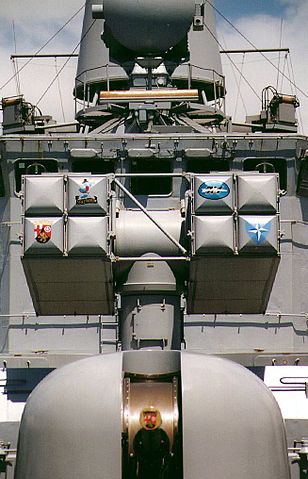 The original equipment was essentially retained but almost all individual systems were replaced by newer versions or replacement over the 1990-2000s. The main armament included the 76mm/62 Compact naval gun from Oto Melara, an octuple RIM-7 Sea Sparrow forward and two quad Harpoon anti-ship missiles as well as two twin 324 mm torpedo tubes for ASW work. It should be precised that the Sea Sparrow could be used against ships as well, at shorter range.
The original equipment was essentially retained but almost all individual systems were replaced by newer versions or replacement over the 1990-2000s. The main armament included the 76mm/62 Compact naval gun from Oto Melara, an octuple RIM-7 Sea Sparrow forward and two quad Harpoon anti-ship missiles as well as two twin 324 mm torpedo tubes for ASW work. It should be precised that the Sea Sparrow could be used against ships as well, at shorter range.
OTO-Melara 76/62 Compatto
They came with a single OTO-Melara 76 mm dual-purpose gun forward. It had the older “compact” rounde cupola and a rate of fire of 85 rounds per minute.
Rounds: 76×636mmR 12.5 kilograms (28 lb) oa, 6.3 kilograms (14 lb) shell alone +2.35 kilograms (5.2 lb) propellant
This 76.2 mm (3.00 in) elevated at −15°/+85° at 35°/s and 360° traverse at 60°/s.
Muzzle velocity was 915 m/s (3,000 ft/s), max range with the HE-PFF: 16,000 m
There were 80 ready rounds.
RIM-7M Sea Sparrow
However their primary asset were the 8-cell launch system with sixteen Sea Sparrow SAM, short range. There was one reload for each below the launcher, so 24 in all. The RIM-7M was capable to hit a target as low as 8 metres (26 ft), so able to destroy sea-skimming missiles such the Exocet.
Mass 510 lb (230 kg), Length 12 ft (3.7 m) x 8 in (20 cm), wingspan 3 ft 4 in (1.02 m).
Carries a 90 lb (41 kg) annular blast fragmentation warhead with proximity fuze and expanding rod, 27 ft (8.2 m) kill radius.
It was powered by a Hercules MK-58 solid-propellant rocket motor for 4,256 km/h (2,645 mph) at max 10 nmi (19 km).
RGM-84A Harpoon SSM

Their Anti-ship missile capability comprised two quadruple Harpoon anti-ship missile launchers located behind the bridge. These trusted systems were adopted instead of the Exocet used by the Kortenaer. In short, this “classic” had a long range than the Exocet at the time, and bigger payload. It weighted 691 kg at 3,8 m x 0,34 m, carrying a 221 kg warhead and thanks to its Teledyne CAE J402 turbojet/solid propellant booster for 600 lbf (2,700 N) of thrust it coukd fly at 537 mph (864 km/h; 240 m/s; Mach 0.71) under the radar up to 75 nmi (139 km), ending its run with an active radar.
324 mm TTs

Antisubmarine warfare comprised two Mark 32 324-mm twin torpedo launchers and height DM4A1 or Mark 46 torpedo in reserve, plus the helicopters. Same systems as the USN, using Mark 46 torpedoes which had a range of 12,000 yd (11,000 m), max depht down to 1,200 ft (370 m) at 40 knots (74 km/h; 46 mph) and using active or passive/active acoustic homing. Once dropped they could stay long enough to acquire their target ans stick to it, whatever its evolution.
Mauser MLG27
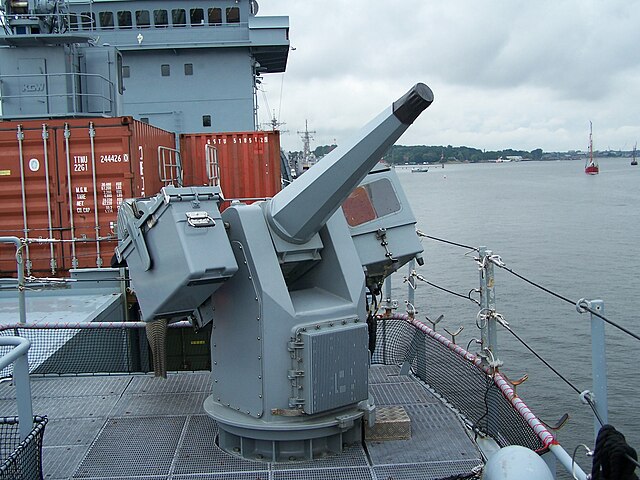
The two Mauser MLG27 27 mm autocannons for close in AA defence were located on the bridge’s shoulders. It originates in the Panavia Tornado, Alpha Jet, JAS 39 Gripen and Eurofighter Typhoon as primary cannons. Rheinmetall thus ddveloped remote-controlled naval versions, the MN 27 GS and the MLG 27, both fully automatic naval guns with 99 MLG 27s ordered by the Bundesmarine over the years. It used pyrotechnic cocking charges to cycle the action and fires mine shells but also a range of AP, HE, Frag, Frap, HESH rounds.
Type: single-barrel, five chamber revolver cannon, breech-cylinder, revolver operation
Caliber: 27 mm × 145 (1.063 in)
Length: 2.31 m (7 ft 7 in)
Weight (complete): 100 kg (220 lb)
Rate of fire: 1,000-1,700 rpm selectable (+/− 100 rpm)
Muzzle velocity: 1,100 m/s (3,600 ft/s), c157,300 Joules
Projectile weight: 260 g (9.2 oz)
Upgrades
In the mid-1990s, the ships underwent a combat upgrade, which included replacing the former DA-08 search radar from Thales Netherlands (formerly Signaal) with a new TRS-3D/32 radar for three-dimensional airspace surveillance, and installing a new command computer and an improved electronic warfare system.
In addition, a number of additional devices were taken on board over time. In the early 1990s, light tube weapons were installed to combat small sea targets, first the 20 mm Rh 202 machine guns on the S20 mount, which were later (from around 2008) replaced by the 27 mm MLG 27 gun, and in the mid-1990s, all ships received the RIM-116 RAM short-range defense system for self-defense against incoming missiles – although this was already planned as original equipment. With the MSP 500 system (multi-sensor platform), the ships also received an electro-optical sensor that could also be used for fire control. As a further improvement, the “DV-Anlage Link 16” data exchange system was installed, which was mainly used to exchange air situation data.
RAM Mk49 CIWS
They received CIWS after modernization, two MK 49 missile launcher, 21 RAM each. This system replaced the classic gun CIWS in service in the USN by the 1980s.
Sensors
The electronic control system used on the Class 122 was the SATIR inherited from the Class 103 destroyer and further developed. The “capability adaptation” modernization planned for classes 122 and 123 will only be implemented for the latter for cost reasons.
Sensors and processing systems:
One EADS TRS-3D air search radar
One WM 25 combined surface search and fire control radar I/J band
One Thales Nederland STIR 18 fire-control radar I/J/K band
One Kelvin Hughes Nucleus 5000 I band navigation radar
One STN Atlas DSQS-23BZ hull-mounted sonar
For Electronic warfare they carried:
-Four Mk 36 SRBOC decoy RL
-(Post refit) One ESM/ECM EADS FL 1800S
-(Post refit) Two SCLAR decoy
-SABRINA CCS
-One SLQ-25 Nixie torpedo decoy
Air Group

The hangar had space for 2 Sea Lynx Mk.88A helicopters with torpedoes, air-to-surface missiles (Sea Skua) and heavy machine gun. They could also perform transport and SAR mission in addition to ASW and ASUW missions.
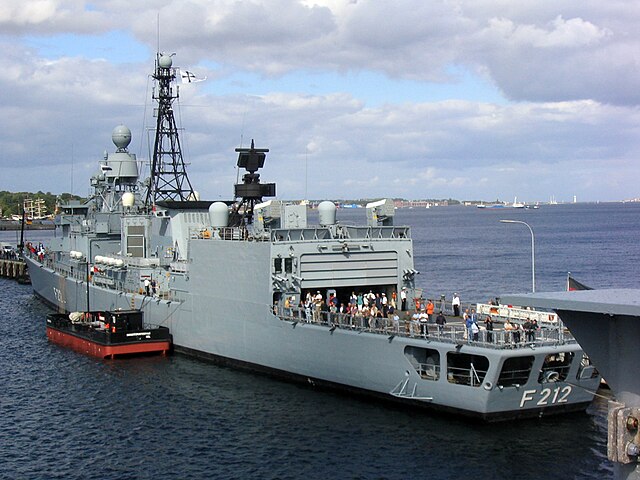
Karlsrühe showing her hangar and helipad
⚙ specifications |
|
| Displacement | 3,680 tonnes (3,620 long tons) FL |
| Dimensions | 130.50 x 14.60 x 6.30 m (428 ft 2 in x 47 ft 11 in x 20 ft 8 in) |
| Propulsion | 2 shafts CODOG, 2× MTU 20V956 TB92 diesel, 2× GE LM2500 GT, 2× Renk STG 150-50 GBx, 4× Deutz MWM diesel-generators |
| Speed | 30 knots (56 km/h) |
| Range | 4,000 nmi (7,400 km) at 18 knots (33 km/h) |
| Armament | OTO-Melara 76 mm, 2× Mauser MLG27 27 mm, 1×8 Sea Sparrow, 2×4 Harpoon, 2×2 Mark 32 324-mm TTs |
| Sensors | EADS TRS-3D ASR, WM 25 combined SS-FCR, STIR 180 FCR, Nucleus 5000 NavR STN Atlas DSQS-23BZ sonar, SCLAR, Nixie |
| Air Group | 2 Sea Lynx Mk.88A helicopters |
| Crew | 202 crew, 20 aviation |
Assessment of the Bremen class
The Bremen-class frigates under procurement specifications were to be a new generation of multi-purpose combat ships, with as main task, anti-submarine warfare. They were still about to fight other surface ships and defenda task force against aircraft and missiles. Withing the late 1970s East-West context, so in wartime, their primary mission was to escort reinforcement transports to Europe and repel incoming Soviet submarines. For this, they had the immense advantage of two on-board helicopters, the first German frigates so equipped. This became a staple of the type since.
After the end of the cold war, the German Navy faced new tasks and the Bremen-class were repurposed, landing ther SSMs (anti ship missiles) for smaller weapons to deal with asymetric threat, more modern electronics and communication facilities to spend half their years in foreign deployements. They truly became the “workhorses of the navy”, taking part in operations by NATO, EU, UN, such as Operation Enduring Freedom, UNIFIL, Atalanta, maritime surveillance, and search of suspicious ships. Between their helicoptern ribs or fast boats and Marines they proved adept in the tasks.
When organized, it was believed four of these eight frigates would be leaders with improved command and control systems and extra staff. That role was to be played much later by the Brandenburg-class frigates, fitted with a better space for a staff.
The F122 design had many versions discussed, ended with the introduction of the Kortenaer class and the final design proved quite different of what they were at the start (refer to the profile above). They started indeed as flush-deck like the previous Köln but longer, larger, with a top structure running for most of her lenght, a low bridge and large 3D radar radome behind. As primary armament they had a Tartar launcher aft and four light guns on her corners, lighter AA guns, torpedo tubes for ASW warfare but no helicopter. However withing NATO a common pan-European frigate design was pressed forward for scale economies.
During the late Cold War period, crews were trained to escort reinforcement convoys and resupply beleaguered NATO in Europe, maintain a bridge in the Northern Atlantic against Soviet submarines. They also frequently took part in NATO Standing Naval Forces and post-1990, took support missions like the UN embargo operations against former Yugoslavia or Operation Enduring Freedom.
Karlsruhe for example assisted an Egyptian freighter repelling pirates on 25 December 2008 (Gulf of Aden) and in 2012 Rheinland-Pfalz reported on Syrian troop movements to profit the Free Syrian Army. In December 2015 Augsburg joined Charles de Gaulle CBG in the Arabian Sea against ISIS in the Syrian Civil War. All this time they proved reliable platforms until the end of their service in 2014-2022.
 F207 Bremen (1979)
F207 Bremen (1979)
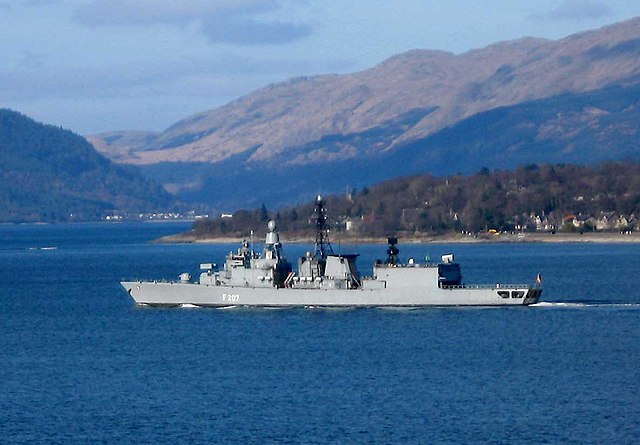
F207 Bremen was laid down at Bremer Vulkan, on 9 July 1979, launched 27 September 1979 and completed on 7 May 1982.
After trials and commission she remained at Wilhelmshaven assigned to the 4. Fregattengeschwader, Einsatzflottille 2. Her 5-bladed Sulzer-Escher propellers were soon replaced with quieter 7-bladed ones from Wegemann & Co. making her also faster and she was the first German frigate to carry a helicopter. She took part in many international missions and with NATO permanent Mediterranean force, notably the during the Gulf War in 1991. In late January 1992 she escorted the freighter Godewind into Cartagena, after being intercepted by the destroyer Mölders with T-72 tanks from Poland to Syria on board. From 1992 to 1996 Bremen was in the Adriatic Sea for Operation Sharp Guard maritime blockade in the Yugoslav Wars. From 2002 she took part in Operation Enduring Freedom. In 2009 she was in Operation Atalanta for anti-piracy at the Horn of Africa. On 14 August 2009 she defeated a pirate attack on the Turkish MS Elgiznur Cebi. The helicopter fired warning shots to force it to stop and the pirate skiff was laterseized by the Greek frigate Narvarinon. By May 2012 with Atalanta, she had a RAS by the oiler Berlin and ceremony attended by Secretary of State Thomas Kossendey. By September 2012 she was relieved by the brand new frigate Sachsen.
In service for 32 years, 1.5 million kilometres under 16 captains she was laid up in Wilhelmshaven for parts, decommissioned on 28 March 2014, Scrapped in Turkey by 2021.
 F208 Niedersachsen
F208 Niedersachsen
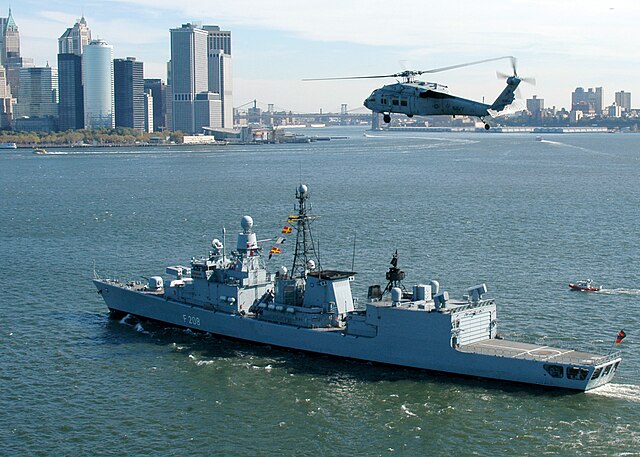
F208 Niedersachsen was laid down at AG Weser, Bremen on 9 November 1979, launched 9 June 1980 and commissioned 15 October 1982,
Niedersachsen by October 1989 sailed with the destroyer Rommel and oiler Coburg to Leningrad, for the the first official German visit there for 77 years. She took part NATO in permanent monitoring missions, notably Standing Naval Force Atlantic (SNFL) and Standing Naval Force Mediterranean (SNFM) in 1992. In 1995 she took part in the UK-led Joint Maritime Course, and Standing Naval Force Mediterranean in 1997. In March she was in Albanian waters for Operation Libelle, evacuation of foreign nationals as unrest broke out, off Durres. She was at Standing Naval Force Atlantic (STANAVFORLANT) in 2000 and 2004, took part in NATO exercise Medshark/Majestic Eagle, by 2007 she joined the UN Interim Force in Lebanon.
From 8 January to 12 June 2008 she joined NATO Maritime Group 2 in the Mediterranean in an international training. In February she was at Operation Active Endeavour, anti-smuggling mission off Egyptian/Lebanon/Albania/Sardinia, visiting 17 ports. In 2011 she was at Operation Atalanta, On 20 April 2011 she repaired a disabled Yemeni dhow. On 10 June she caught a fishing dhow and two attack skiffs. She returned in 2013. On 5 November she caught a whaler towing a skiff. In 2014 she was at Standing NATO Maritime Group 2 and Operation Active Endeavour. She was decommissioned on 26 June 2015, scrapped, 2021-22.
 F209 Rheinland-Pfalz
F209 Rheinland-Pfalz
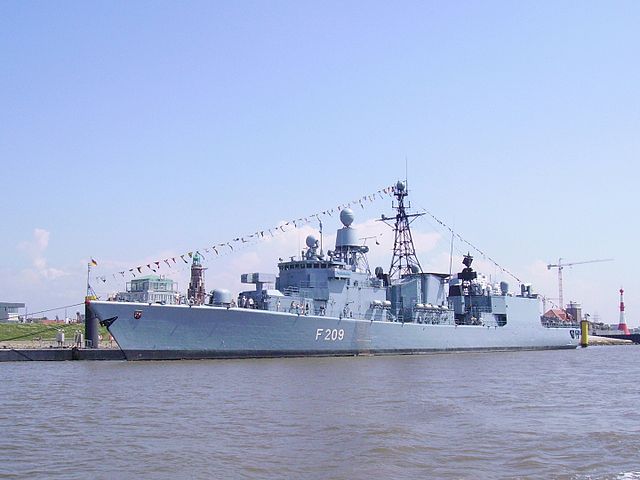
F209 Rheinland-Pfalz was laid down at Blohm + Voss, Hamburg on 25 September 1979, launched 3 September 1980, commissioned on 9 May 1983.
Rheinland-Pfalz from 1992 to 1996 was deployed for Operation Sharp Guard. In 1999 she supported Operation Allied Force on Yugoslavia. In 2001 she she took part in a large Destroyer Exercise (DESEX), and by 2004 in Operation Enduring Freedom in the Horn of Africa and Gulf of Aden, then Operation Active Endeavour Mediterranean 2005, and was the next year in the South African naval exercises Good Hope II. By early 2009 she returned to Operation Active Endeavour, then Operation Atalanta off Somalia, relieving Karlsruhe on 22 January.
On 3 March she intervened with her helicopter to save MV Courier attacked by RMGs and Kalashnikovs, when she was 50 nm away. Her Westland Lynx fired warning shots soon joined by a Sikorsky SH-60 Seahawk from USS Monterey. Later she captured the skiff by a party of German marines. On 30 March 2009, the tanker Spessart was assaulted, but reissted with its on-board security detachment, the Rheinland-Pfalz joined her at full speed and captured the skiffs. On 3 August 2009 she escorted the just released MV Hansa Stavanger to Mombasa, Kenya. In 2011, February she evacuated civilians on the Libyan coast caught in the Civil War. On 5 March 2011 she entered Gabès, with Brandenburg and oiler Berlin, to pick up several hundred Egyptian refugees, to Alexandria.
On 1 February 2012 she joined standing NATO Maritime Group 1 (STANAMG 1) in the Mediterranean, her last international deployment. She was decommissioned on 22 March 2013, Scrapped, 2017
 F210 Emden
F210 Emden
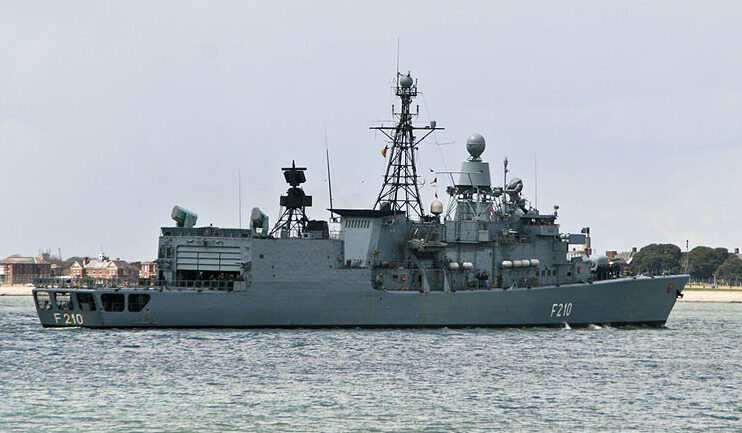
F210 Emden was laid down at Nordseewerke, Emden on 23 June 1979 launched 17 December 1980, commissioned 7 October 1983. She was based at Wilhelmshaven, 4. Fregattengeschwader, Einsatzflottille 2 and given her famous named, carried a large Iron Cross decoration in memory of the initial SMS Emden. This Iron Cross was displayed at the front of the bridge until removal from active service. She took part in Australian Navy’s International Fleet Review, Sydney. In 1984 she won the “Barbarian Prize” for best gunnery skills. She trained off the UK, Portland. Missing logs until January-March 1994, when she was flagship of Kapitän zur See Henning Bess, commander of 4. Fregattengeschwader for DESEX 1/94 in the South Atlantic. Emden was refuelled by the tanker Rhön, and resupplied by Freiburg. She sailed to Dakar with the Royal Navy and French Navy. Next she stopped at Buenos Aires, Montevideo, Mar del Plata and Recife, then Roosevelt Roads Naval Station with Niedersachsen for gunnery practice. In 1995 and 1996 she became flagship for Flottillenadmiral Frank Ropers. By June 1996 she was in Operation Sharp Guard. In October 1998 she collided with the Kaiser Wilhelm Bridge. Later she took part in Operation Enduring Freedom 2002, 2006 and 2008, and TANMAG 1 in Operation Active Endeavour until November 2006.
In 2008’s Operation Enduring Freedom (12 February-8 July) she was at the Horn of Africa. On 21 April she defeated pirates attacking the oil tanker Takayama. On 23-24 April she escorted the sailing ship Star Clipper. On 28 June she assisted the merchant Amiya Scan released from pirate control, providing supplies and help.
Her trip to Australia was cancelled and she policed thee Suez Canal in Operation Atalanta. She made another such deployment from January 2010 to 19 May 2010, relieved by Schleswig-Holstein. On 19 February she investigated a dhow and skiff acting strangely. On 11 March she answered a call and came across a mothership and two skiffs, sending a boarding party. On 18 March she rescued the Spanish fishing vessel Albatun 2. Two days later she caught anotehr mothership with two skiffs were discovered. In 2013 she took part in an annual training voyage and returning to Wilhelmshaven, removed from active service, decommissioned on 29 November 2013, laid up in Wilhelmshaven, still there.
 F211 Köln
F211 Köln
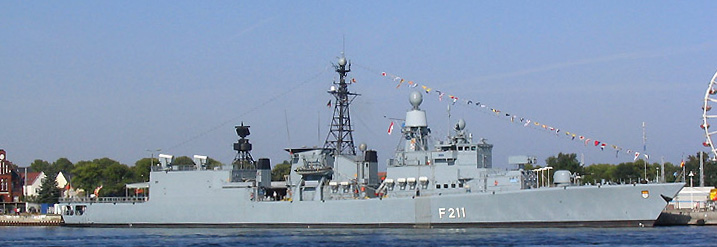
F211 Köln was laid down at Blohm + Voss in Hamburg on 16 June 1980, launched on 29 May 1981 anc commissioned on 19 October 1984.
Like her sisters she was in 4. Fregattengeschwader, Einsatzflottille 2 and by early July 1988 she was in a NATO squadron looking for survivors from the Piper Alpha oil platform, North Sea, destroyed in a fire. From January to March 1991 she became flagship of the German naval forces in the Gulf War. From January to April 1994 she took part in Operation Southern Cross of the Deutscher Unterstützungsverband Somalia, Somalia II. She was flagship of Task Group 500.02 off the Somali coast and on 7 September 2000 joined STANAVFORMED with USS Caron, HMS York, Luigi Durand de la Penne, HNLMS Van Amstel, Spetsai, TCG Trakya and Numancia. She visited Tunisia and several other ports but her visit to Haifa was cancelled.
From 2 January 2002 she joined Operation Enduring Freedom and spent 6½ months there. She returned the next year to the Horn of Africa/Peninsula from April to October 2007, relieving Bremen at Combined Task Force 150. On 30 August 2010 Köln joined Operation Atalanta, relieved by Schleswig-Holstein in December 2010. She made her final deployment on 29 August 2011, Operation Atalanta, and back on 9 December 2011. She was decommissioned on 31 July 2012, scrapped, 2016-17.
 F212 Karlsruhe
F212 Karlsruhe

F212 Karlsruhe was laid down at Howaldtswerke, Kiel on 10 March 1981, launched 8 January 1982 and commissioned on 19 April 1984.
She was part of 4. Fregattengeschwader, forming a component of Einsatzflottille 2. While in the Adriatic by the mid-1990s she was temporarily testing the Goalkeeper CIWS, and in 1995 received the RIM-116 Rolling Airframe Missile (RAM) system. In 1998 she received a new central computer and TRS 3D/32 radar antenna. Her deployments aboard started from August to December 1993 in Operation Sharp Guard, the Yugoslav Wars blockade. From February to April 1994 she took part in Operation Southern Cross, with Deutscher Unterstützungsverband Somalia, UN Somalia II. From December 1995 to April 1996 she retruned to Operation Sharp Guard. From October 2001 to February 2002 this was Operation Active Endeavour, then Operation Enduring Freedom at the Horn of Africa (June-October 2002, March-September 2005) and assisted the UN Interim Force in Lebanon (eptember 2006-March 2007) with extra deployments in the Mediterranean and Middle East with Standing NATO Maritime Group 2 in 2008. She made several deployment for Operation Atalanta, first in December 2008, last from November 2012 to April 2013. In March-June 2016 she took part in Operation Sophia in the Mediterranean, recsuing 663 from shipwrecks and made a final deployment was from June to September 2016 as flagship STANAMG 2, until relieved by HNLMS De Ruyter on 1 September 2016. She was back to Wilhelmshaven on 16 December 2016 after 183 days at sea. She was decommissioned after being prepared as target ship, on 16 June 2017, Laid up in Wilhelmshaven, to sunk as target.
 F213 Augsburg
F213 Augsburg
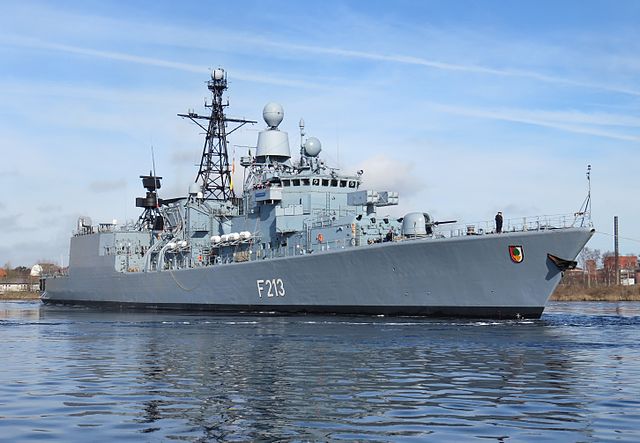
F213 Augsburg was laid down at Bremer Vulkan on 4 April 1987, launched 17 September 1987, commissioned on 3 October 1989.
She was also in 4. Fregattengeschwader, Einsatzflottille 2 and acted as “Wilde 13” in a movie. SDhe was soon reassigned to to 2. Fregattengeschwader, 4. Fregattengeschwader on 9 January 2006. She took part in Operation Enduring Freedom and generally served yearly in the Mediterranean Sea. From 3 April 2013 to 30 August 2013 while under Fregattenkapitän Bernhard Veitl, she almost stayed 6 months for Operation Atalanta. On 11 February unti 20 June 2014 she took part in annual training and exercises with manoeuvres to the Arctic Circle and Equator, visiting 13 ports, nine countries.
On 9 April 2014 she joined the US special purpose vessel MV Cape Ray in the eastern Mediterranean, transporting Syrian chemical weapons for destruction. On 20 November 2015, she took part in Operation Sophia in the Mediterranean, relieved by the minehunter Weilheim.
On 6 December 2015 she escorted the French aircraft carrier Charles de Gaulle during operations against the Islamic State of Iraq and the Levant, relieved on 11 March, her crew being awarded the French Overseas Medal for their service. She was back on 24 March. On 30 August 2016 she retrtned as escort for the Charles De Gaulle and carried out indepedent patrols. She also took part in Operation Sea Guardian, and back to Wilhelmshaven on 25 November 2016. On 17 September 2018 she relieved the tender Mosel in Operation Sophia. She was decommissioned on 30 June 2019, Laid up in Wilhelmshaven.
 F214 Lübeck
F214 Lübeck
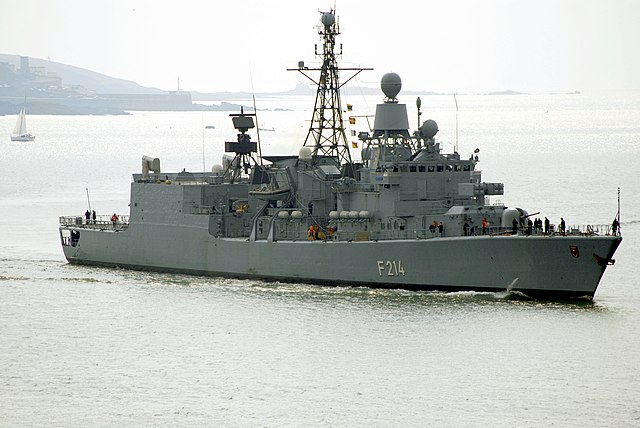
F214 Lübeck was laid down at Nordseewerke, Emden on 1 June 1987, launched 15 October 1987, commissioned on 19 March 1990. In 1994, 1995 and 1996 she was in the Adriatic Sea for Operation Sharp Guard. In 2003-2004, and 2005-2006, she was at Operation Enduring Freedom. In November 2005 she escorted the MS Deutschland through the Gulf of Aden. In July 2007 she joined the UN force off Lebanon. From 21 August she was in STANAMG 1 for routine exercises in the Black Sea and presence off the Georgian coast (Russo-Georgian War) with USS Taylor, Blas de Lezo and ORP Generał Kazimierz Pułaski. In 2007 she visited Devonport for training ahd damaged her bow by firing own bow gun too low. In 2009 she took part in UNITAS Gold and fired two RIM-7 Sea Sparrow at the decom. target DD USS Conolly. Between 2009 and 2010 she was in overhaul at Bremerhaven. In 2011 she was at STANAMG 1 and Operation Unified Protector (Libyan Civil War), then Operation Active Endeavour. She left Germany on 18 November 2011 for Operation Atalanta. On 17 January 2012 she chased pirates attacking MV Flintstone. Her helicopter destroyed the skiffs and crippled the Dhow, captured. Pirates ended on the MV Enrico Ievoli, releasing 15 hostages.
She trained with the South African Navy and was back on 20 April 2012. 2013 saw her refit at Kiel and bac to Operation Atalanta, autumn 2014. On 21 August 2017 she relieved Brandenburg in STANAMG 2 in the Aegean Sea at Souda, Crete.
From January to June 2022, she made her last deployment in the Aegean, back home in June 2022, formally decommissioned on 15 December 2022 after 570,000 nautical miles, 43 missions, 124 ports visits in 38 countries. She Laid up in Wilhelmshaven, still is there waiting for recycling.
Read More/Src
Books
Links
https://www.seaforces.org/marint/German-Navy/Aviation/Sea-King-Mk41.htm
https://www.bundeswehr.de/de/organisation/marine
https://www.navypedia.org/ships/germany/ger_es_bremen.htm
Videos
Model Kits
3D
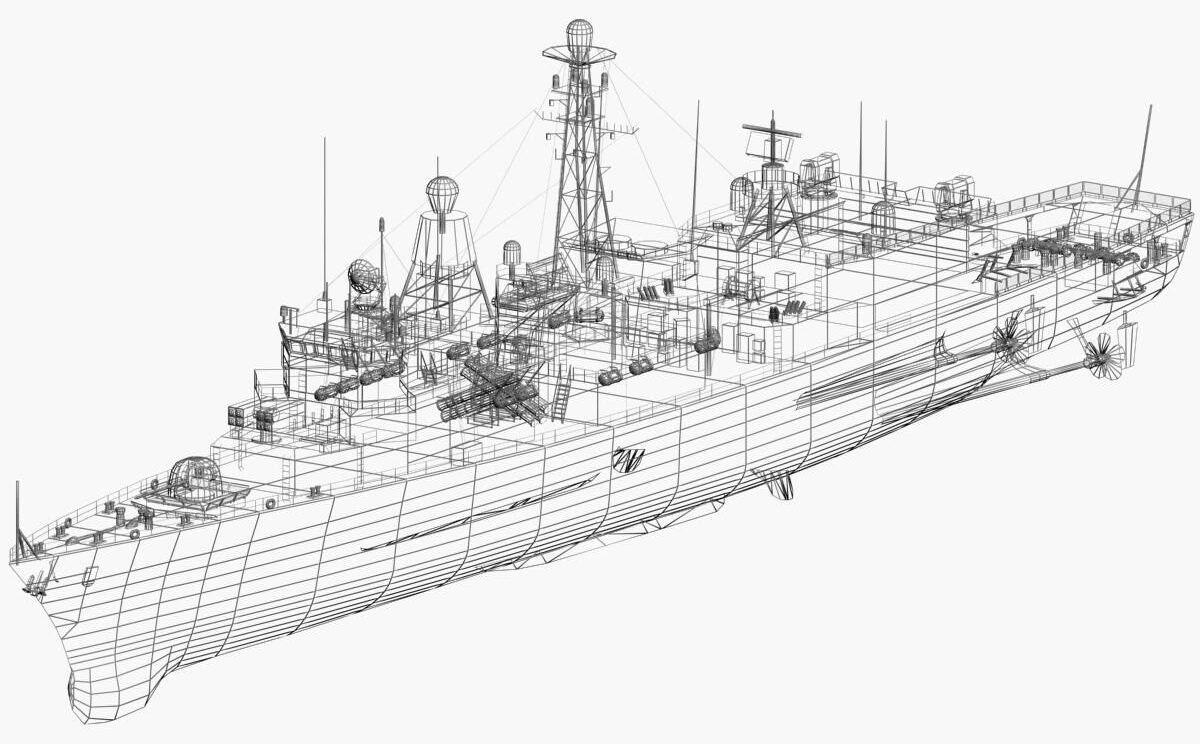
https://free3d.com/3d-model/f122-bremen-class-german-frigate-1564.html

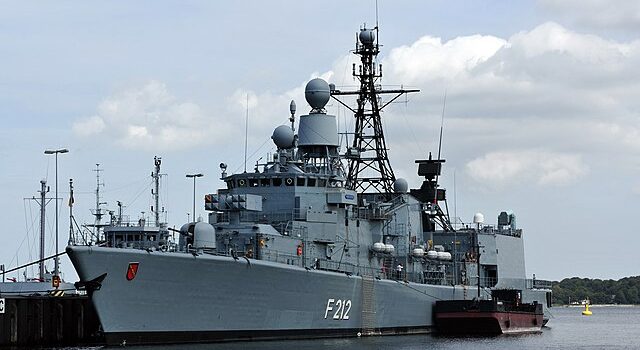

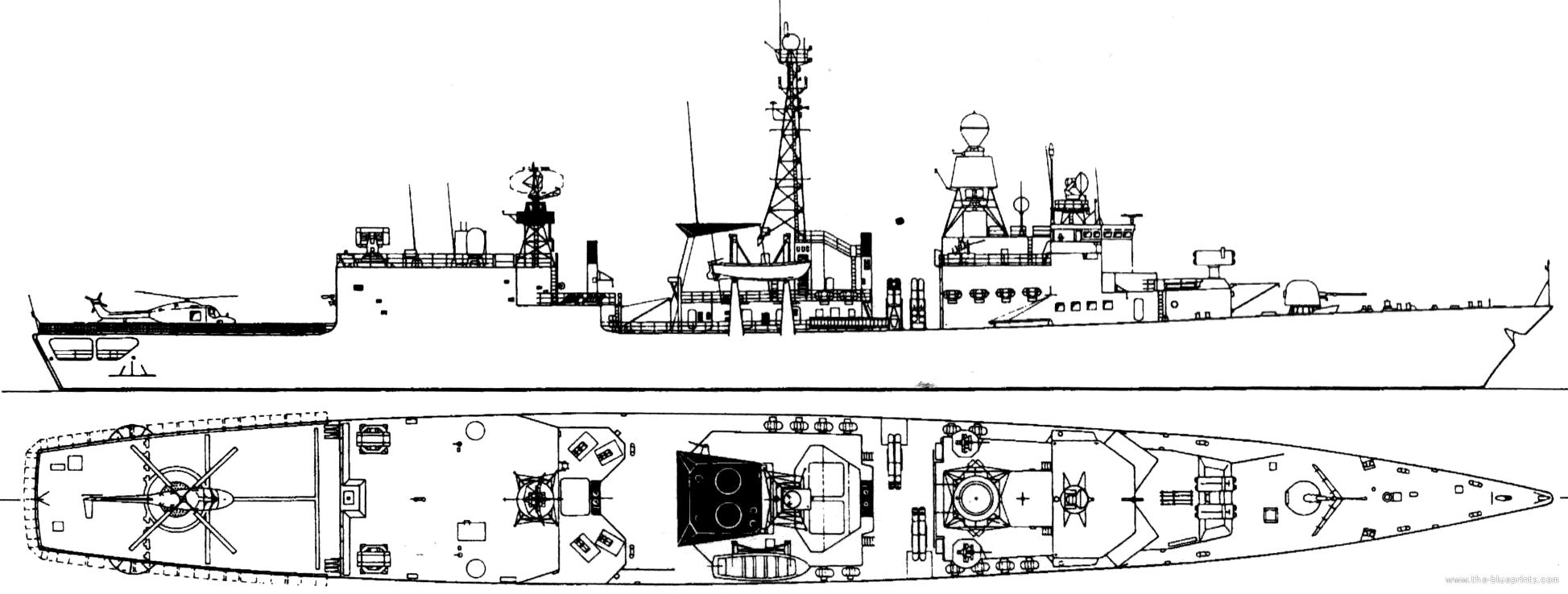

 Latest Facebook Entry -
Latest Facebook Entry -  X(Tweeter) Naval Encyclopedia's deck archive
X(Tweeter) Naval Encyclopedia's deck archive Instagram (@navalencyc)
Instagram (@navalencyc)





 French Navy
French Navy Royal Navy
Royal Navy Russian Navy
Russian Navy Armada Espanola
Armada Espanola Austrian Navy
Austrian Navy K.u.K. Kriegsmarine
K.u.K. Kriegsmarine Dansk Marine
Dansk Marine Nautiko Hellenon
Nautiko Hellenon Koninklije Marine 1870
Koninklije Marine 1870 Marinha do Brasil
Marinha do Brasil Osmanlı Donanması
Osmanlı Donanması Marina Do Peru
Marina Do Peru Marinha do Portugal
Marinha do Portugal Regia Marina 1870
Regia Marina 1870 Nihhon Kaigun 1870
Nihhon Kaigun 1870 Preußische Marine 1870
Preußische Marine 1870 Russkiy Flot 1870
Russkiy Flot 1870 Svenska marinen
Svenska marinen Søværnet
Søværnet Union Navy
Union Navy Confederate Navy
Confederate Navy Armada de Argentina
Armada de Argentina Imperial Chinese Navy
Imperial Chinese Navy Marinha do Portugal
Marinha do Portugal Mexico
Mexico Kaiserliche Marine
Kaiserliche Marine 1898 US Navy
1898 US Navy Sovietskiy Flot
Sovietskiy Flot Royal Canadian Navy
Royal Canadian Navy Royal Australian Navy
Royal Australian Navy RNZN Fleet
RNZN Fleet Chinese Navy 1937
Chinese Navy 1937 Kriegsmarine
Kriegsmarine Chilean Navy
Chilean Navy Danish Navy
Danish Navy Finnish Navy
Finnish Navy Hellenic Navy
Hellenic Navy Polish Navy
Polish Navy Romanian Navy
Romanian Navy Turkish Navy
Turkish Navy Royal Yugoslav Navy
Royal Yugoslav Navy Royal Thai Navy
Royal Thai Navy Minor Navies
Minor Navies Albania
Albania Austria
Austria Belgium
Belgium Columbia
Columbia Costa Rica
Costa Rica Cuba
Cuba Czechoslovakia
Czechoslovakia Dominican Republic
Dominican Republic Haiti
Haiti Hungary
Hungary Honduras
Honduras Estonia
Estonia Iceland
Iceland Eire
Eire Equador
Equador Iran
Iran Iraq
Iraq Latvia
Latvia Liberia
Liberia Lithuania
Lithuania Mandchukuo
Mandchukuo Morocco
Morocco Nicaragua
Nicaragua Persia
Persia San Salvador
San Salvador Sarawak
Sarawak Uruguay
Uruguay Venezuela
Venezuela Zanzibar
Zanzibar Warsaw Pact Navies
Warsaw Pact Navies Bulgaria
Bulgaria Hungary
Hungary

 Bundesmarine
Bundesmarine Dutch Navy
Dutch Navy Hellenic Navy
Hellenic Navy Marina Militare
Marina Militare Yugoslav Navy
Yugoslav Navy Chinese Navy
Chinese Navy Indian Navy
Indian Navy Indonesian Navy
Indonesian Navy JMSDF
JMSDF North Korean Navy
North Korean Navy Pakistani Navy
Pakistani Navy Philippines Navy
Philippines Navy ROKN
ROKN Rep. of Singapore Navy
Rep. of Singapore Navy Taiwanese Navy
Taiwanese Navy IDF Navy
IDF Navy Saudi Navy
Saudi Navy Royal New Zealand Navy
Royal New Zealand Navy Egyptian Navy
Egyptian Navy South African Navy
South African Navy






























 Ukrainian Navy
Ukrainian Navy dbodesign
dbodesign